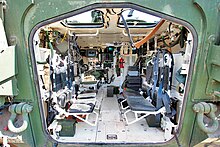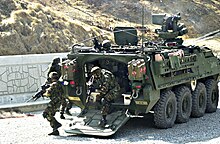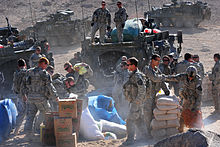Stryker
The agreement built off earlier cooperative effort: In January 1999, General Dynamics Land Systems (GDLS)–Canada integrated its Low Profile Turret (LPT) onto an assault gun version of the LAV III.
[citation needed] General Dynamics's Robotic Systems division was developing autonomous navigation for the Stryker and several other vehicles with a $237 million contract, until the program was cut in July 2011.
[27] Throughout its years in service, the Stryker has undergone various survivability upgrades and received "kit" applications designed to improve the vehicle's ability to withstand attacks.
Included are additional armor for the sides, redesigned hatches to minimize gaps in the armor, blast-absorbent, mine-resistant seating, non-flammable tires, an upgrade to the remote weapon station that allows it to fire while moving, increased 500 ampere electrical generation, a new solid-state power distribution system and data bus, and the automotive and power plant systems improvements to support one-fourth greater gross vehicle weight.
[29] The upgrade incorporating lessons learned from combat in Afghanistan is designated LAV-H. General Dynamics had a technology demonstrator displayed at the 2007 Association of the United States Army (AUSA) Exposition.
[41] Phase 1 of the ECP includes an electrical power upgrade by replacing the extant 570 amp alternator with a higher current 910 amp alternator, replacing the existing 350 horsepower engine with a 450-horsepower engine, a stronger suspension system to improve mobility at higher weights, and an in-vehicle network to improve data and video sharing between crew stations and more secure and reliable data sharing between vehicle systems.
The Strykers will be the first to receive ECPs to handle the upgrades better than the previous three brigade vehicles, which increased weight, decreased mobility, and added a power burden.
[49] In February 2018, the Army announced that Stryker vehicles would be modified with sensors and weapons to fulfill an interim Maneuver-Short-Range Air Defense (M-SHORAD) requirement.
In addition to deploying AN/TWQ-1 Avengers and fielding man-portable Stinger missiles, Strykers are to be upgraded to buy time to build a lasting mobile air defense solution.
[50] Because the unarmored Humvee-based Avenger lacks survivability and range to keep up with maneuver forces and hold off enemy aircraft in contested territory, four battalions totaling 144 Stryker SHORADs are planned, with the first battery of 12 systems fielded in 2020.
[51] In June 2018, the Army chose Leonardo DRS to supply the mission equipment package, which partnered with Moog Inc. to integrate the Reconfigurable Integrated-weapons Platform (RIwP) onto the vehicle.
It posed less intrusion to the existing vehicle platform, as they have a desire to keep the Stryker as common across the fleet as possible, and it provided increased protection as the crew can reload ammunition under armor.
[59] A combat shoot-off of laser-equipped Strykers facing realistic scenarios was conducted in July 2021,[60] after which Raytheon was awarded a contract to supply a platoon of four vehicles each equipped with a 50 kW laser to defend against Group 1-3 UAS and rocket, artillery, and mortar (RAM) threats.
The AN/VAS–5 Driver’s Vision Enhancer (DVE), a compact thermal camera with a high-resolution infrared sensor, provides a 50-degree field of view for effective navigation in low-visibility environments such as fog, smoke, and dust.
[78] In 2005, slat armor for the Stryker vehicles was designed and developed by the Army Research Laboratory and the Aberdeen Test Center in Maryland to further protect them from RPGs.
The additional weight of the two systems is comparable, but reactive armor tiles offer greater vehicle stability and maneuverability and "assured" rather than "statistical" protection.
[82][83] In spring 2016, a Stryker regiment deployed to Europe with the Saab mobile camouflage system (MCS), which both changes its physical appearance to better blend into the environment and incorporates properties that improve signature management against long-wave and mid-wave thermal sensors, near-wave and short-wave infrared, and radar.
In September 2017, Raytheon fired Stinger missiles it had integrated into a Stryker-mounted Common Remotely Operated Weapon Station (CROWS) to intercept airborne targets in a demonstration, turning the vehicle into a short-range air defense system.
[87] In August 2018, 86 Strykers began fielding with a CROWS turret adapted to be able to fit a FGM-148 Javelin tube, allowing the vehicle to fire the weapon instead of needing dismounted troops to use it.
[89] The Army planned to test stabilized 30 mm cannons in early 2014, including Kongsberg Protech Systems' Medium Caliber Remote Weapons Station (RWS).
[108] On September 26, 2024, a $78.5 million production contract was awarded to Northrop Grumman Defense Systems for the XM1182 High Explosive Airburst with Tracer (HEAB-T), designed for the ICVVA1-30mm Stryker.
Additionally, the XM1182 HEAB-T includes an advanced warhead with increased fragmentation, providing a larger lethal footprint and improved penetration of urban structures.
[4] In 2013, media reports stated that the Stryker Project Management Office had ordered almost $900 million in unneeded or outdated parts due to a failure to control its inventory during the War on Terror.
[49] The Stryker family of vehicles fills a role in the United States Army that is neither heavy nor light, but rather an attempt to create a force that can move infantry to the battlefield quickly and in relative security.
For these units, the addition of Strykers has increased combat power by providing armor protection, a vehicle-borne weapon system to support each dismounted squad, and the speed and range to conduct missions far from the operating base.
[citation needed] Stryker units seem to be especially effective in urban areas, where vehicles can establish initial security positions near a building and dismount squads on a doorstep.
[132] A 2005 Washington Post article states that "commanders, soldiers and mechanics who use the Stryker fleet daily in one of Iraq's most dangerous areas unanimously praised the vehicle.
A 2003 GAO report to Congress stated that the added weight of slat armor created a mobility limitation in wet conditions due to shortcomings in the vehicle's suspension.
[138] Maj. Doug Baker, executive officer of the 5th Battalion, 20th Infantry Regiment in 3/2 said, "When you rolled out the gate, you were fairly confident that the vehicle was going to take care of you… I'm familiar with what a Bradley can do.
"[138] Crew members of the Stryker Mobile Gun System attest to its "seamless" ability to fill the high-mobility niche between main battle tank and armored personnel carrier.























